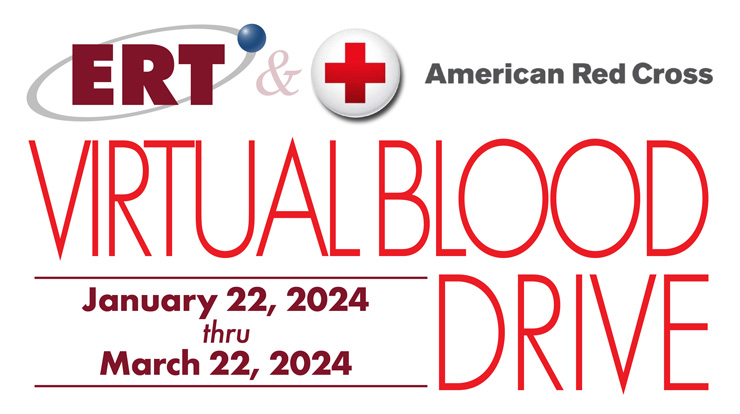
ERT has partnered with the American Red Cross to create a virtual blood drive from January 22 – March 22, 2024! When you pledge, the American Red Cross will identify the best donation venues near you so you can choose the most convenient location!
Giving the “right” type of blood donation – based on your blood type and patient needs – helps ensure the best use of your valuable contribution. Here are some things to consider when determining how you can have the most impact.
Whole Blood Donation
Whole blood is the most flexible type of donation. It can be transfused in its original form or used to help multiple people when separated into its specific components of red cells, plasma and platelets.
Who it helps: Whole blood is frequently given to trauma patients and people undergoing surgery.
Time it takes: About 1 hour
Ideal blood types: All blood types
Donation frequency: Every 56 days, up to 6 times a year
Requirements: Must be in good health and feeling well. Must weigh at least 110 lbs.
Power Red Donation
During a Power Red donation, you give a concentrated dose of red cells, the part of your blood used every day for those needing transfusions as part of their care. This type of donation uses an automated process that separates your red blood cells from the other blood components, and then safely and comfortably returns your plasma and platelets to you.
With just a little extra time at your appointment, you can donate more red cells and increase your impact on patients in need.
Who it helps: Red cells from a Power Red donation are typically given to trauma patients; newborns and emergency transfusions during birth; people with sickle cell anemia; and anyone suffering from blood loss.
Time it takes: About 1.5 hours
Ideal blood types: O positive, O negative, A negative, and B negative
Donation frequency: Every 112 days, up to 3 times a year
Requirements: Must be in good health and feeling well. Male donors must be at least 17 years old and at least 5’1’ tall and weigh at least 130 lbs. Female donors must be at least 19 years old, at least 5’3” and weigh at least 150 lbs.
Platelet Donation
Platelets are tiny cells in your blood that form clots and stop bleeding. Platelets are most often used by cancer patients and others facing life-threatening illnesses and injuries.
In a platelet donation, an apheresis machine collects your platelets along with some plasma, returning your red cells and most of the plasma back to you. A single donation of platelets can yield several transfusable units, whereas it takes about five whole blood donations to make up a single transfusable unit of platelets.
Platelets are collected and Red Cross donation centers only and are not collected at blood drives.
Who it helps: Platelets are a vital element of cancer treatments and organ transplant procedures, as well as other surgical procedures.
Time it takes: About 2.5 – 3 hours
Ideal blood types: A positive, A negative, B positive, O positive, AB positive and AB negative
Donation frequency: Every 7 days, up to 24 times a year
Requirements: Must be in good health and feeling well. Must weight at least 110 lbs.
Plasma Donation
During an AB Elite donation, you give plasma, a part of your blood used to treat patients in emergency situations. AB plasma can be given to anyone regardless of their blood type. Plasma is collected through an automated process that separates plasma from other blood components, then safely and comfortably returns your red blood cells and platelets to you. AB Elite maximizes your donation and takes just a few minutes longer than donating blood.
Plasma is collected at select Red Cross donation centers.
Who it helps: AB Plasma is used in emergency and trauma situations to help stop bleeding.
Time it takes: About 1 hour and 15 minutes.
Ideal blood types: AB positive, AB negative
Donation frequency: Every 28 days, up to 13 times a year
Requirements: Must have type AB blood. Must be in good health and feeling well. Must weight at least 110 lbs.
Even if you were deferred in the past, you may be eligible to donate now. For more information regarding the common deferral reasons, read below, and take a look at the American Red Cross Eligibility Requirements page.